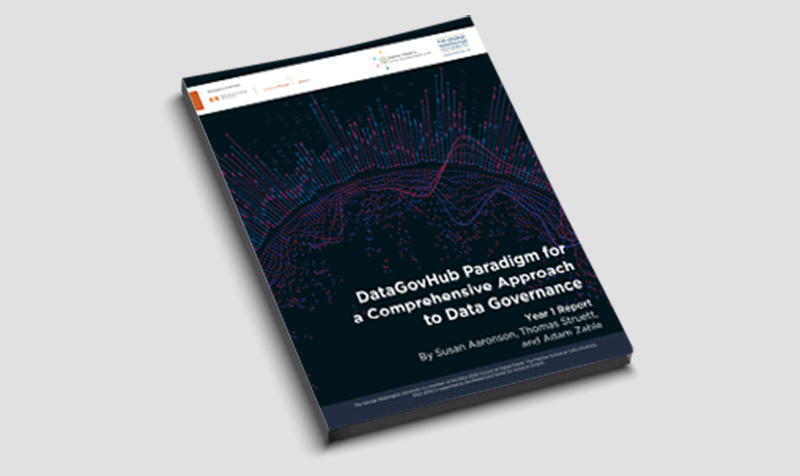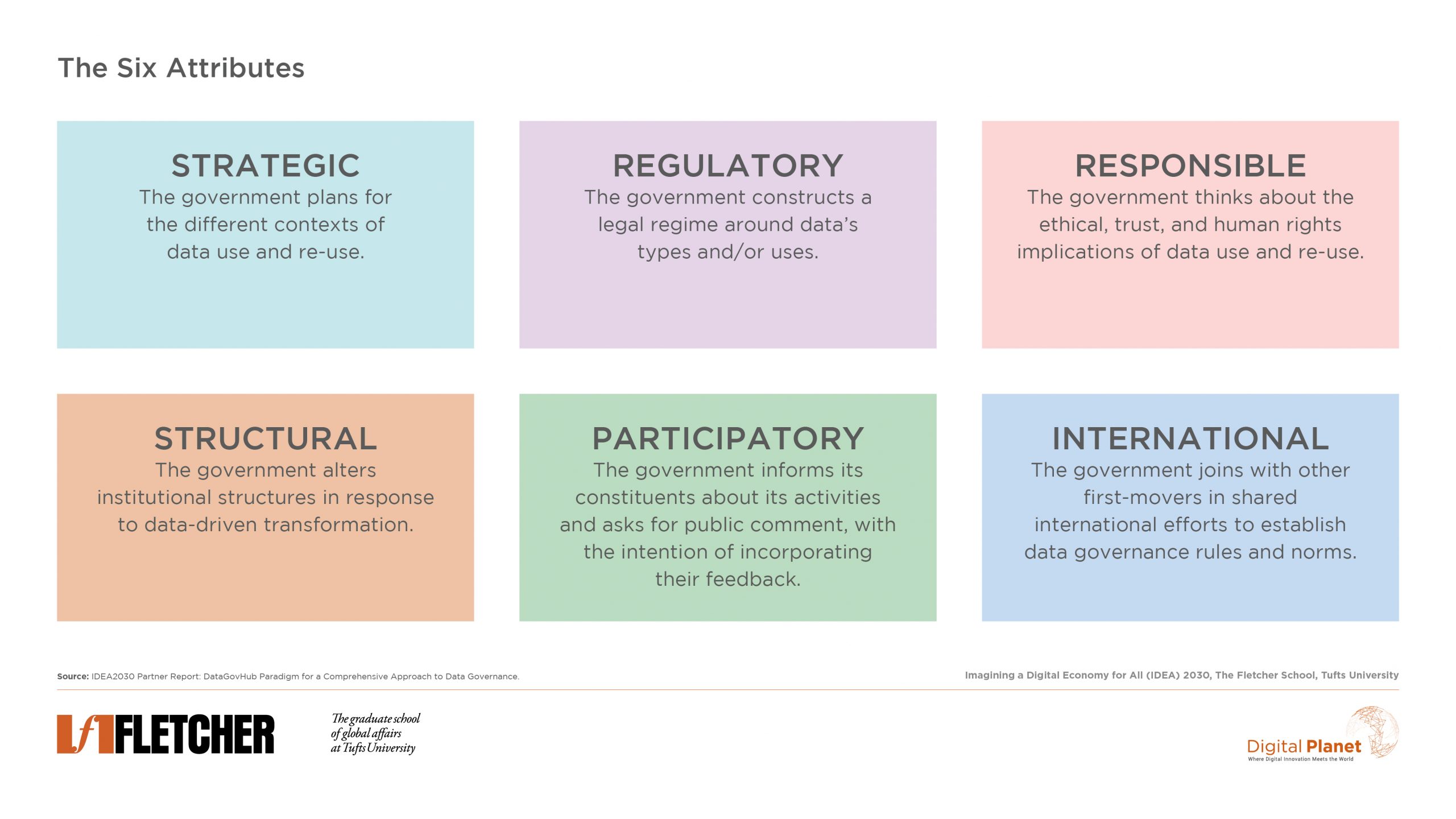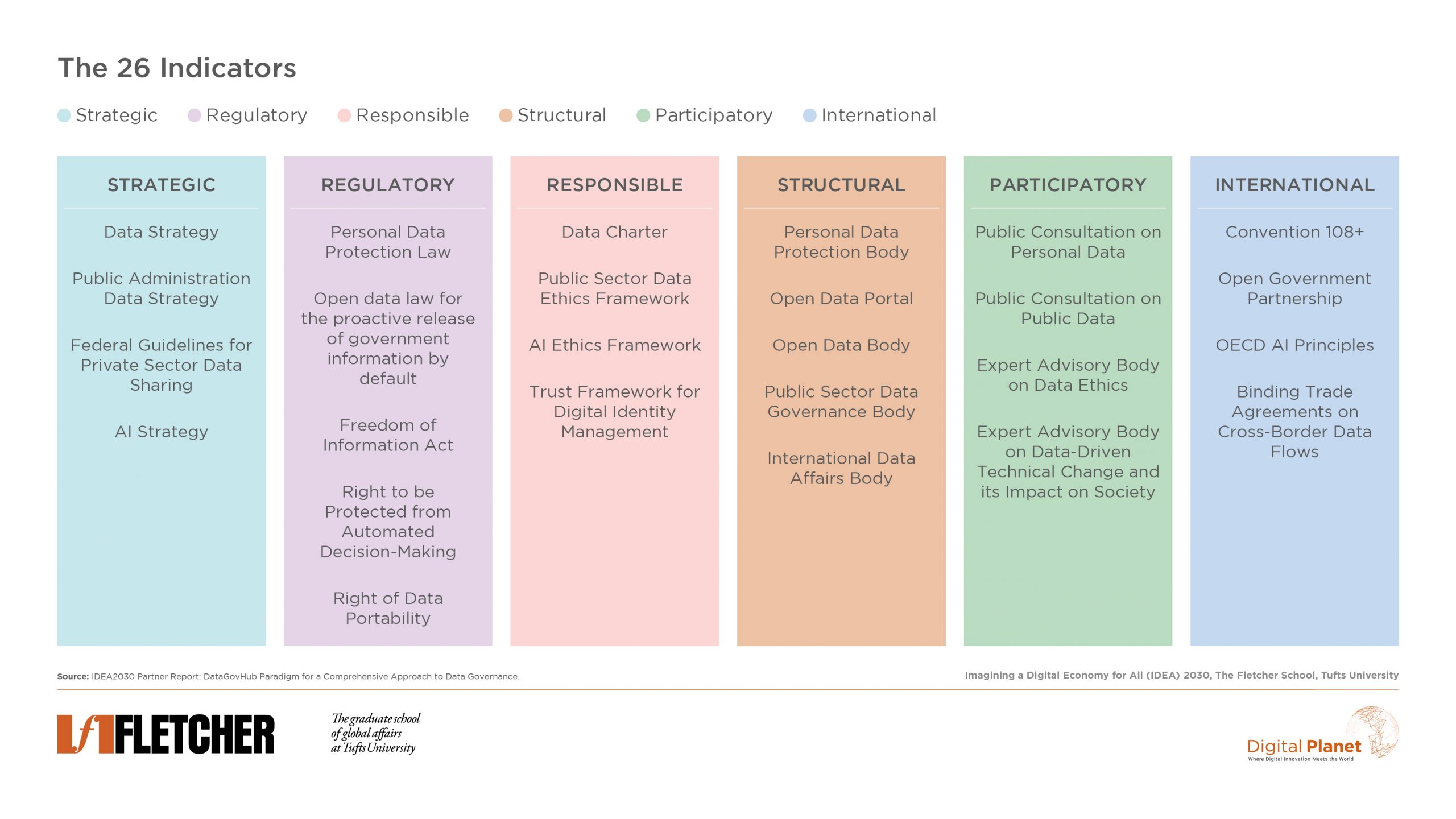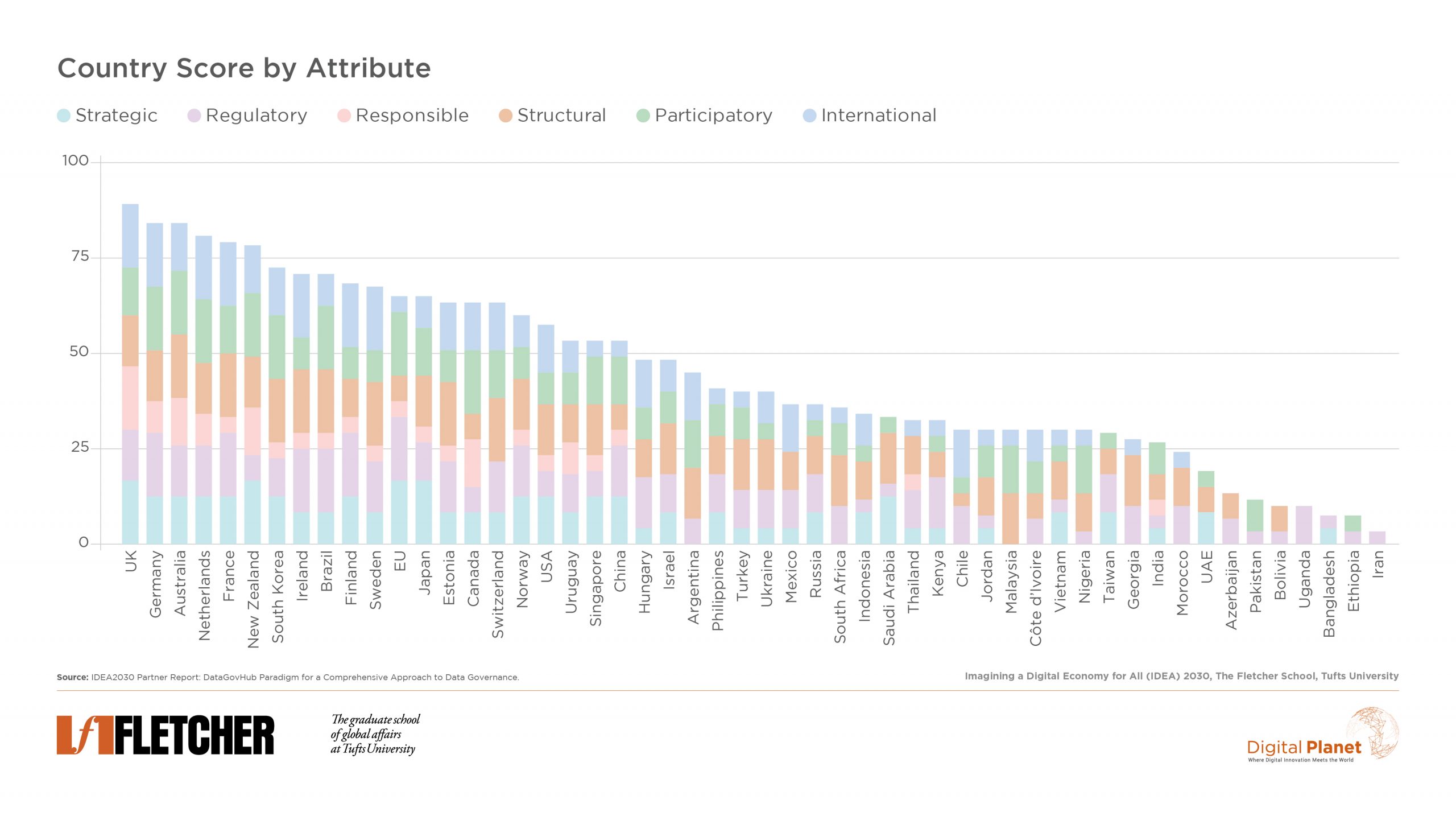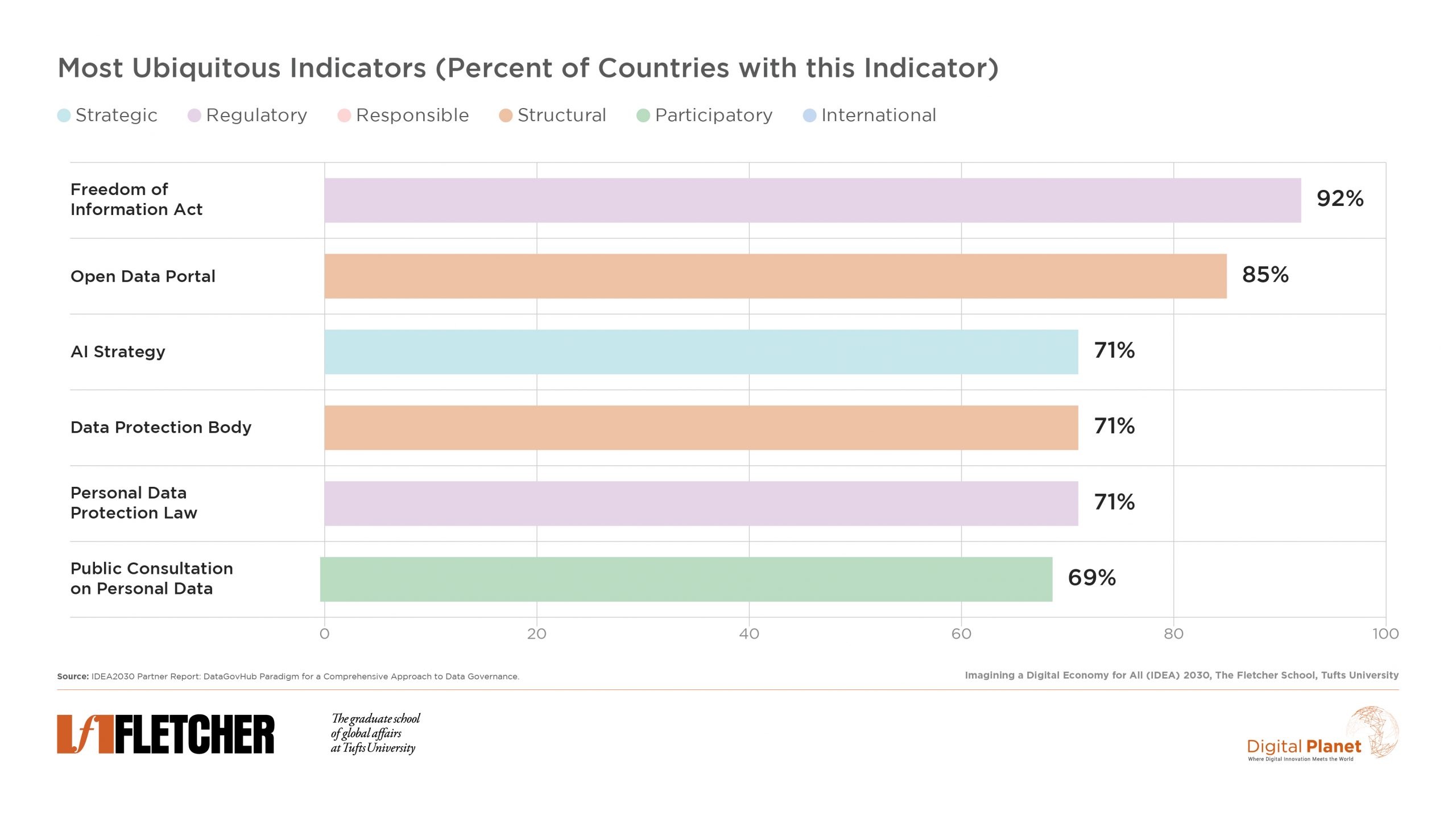Home > IDEA 2030 > Off the Charts > DataGovHub Paradigm for A Comprehensive Approach to Data Governance
DataGovHub Paradigm For a Comprehensive Approach to Data Governance
Summary
In collaboration with Digital Planet, the Digital Trade and Data Governance Hub at George Washington University has come up with the first comprehensive data governance metric in the world. Six attributes—structural, regulatory, participatory, international, strategic, and responsible—describe the dimensions of action a government takes in moving toward comprehensive data governance.
Data governance around the world is constantly changing to accommodate the dynamic nature of data itself. In its inaugural report the Data Governance Hub at George Washington University aims to map data governance strategies around the world. The following is a short summary of the findings, we encourage readers to read the full report.
According to the OECD, data governance refers to principles and policies that guide how governments can maximize the cross-sectoral benefits of all kinds of data, while protecting the rights of individuals and organizations. Governments around the world, thus, have begun implementing data governance strategies and policies as part of their general governance.
The Data Governance Hub created the first metric of comprehensive data governance around the world, using 26 different indicators in six categories. Data, and consequently data governance, is dynamic and constantly changing. Data governance can be considered a work in progress and is implemented and enforced in a variety of different ways. For example, the United States placed 18th on the metric, with a score of 57.5, while India only scored 26.7 points, placing 42nd. Despite the massive difference in scores, both countries have some set of AI guidelines or strategy in place.
Understanding the main attributes of data governance
Each of the 51 countries studied is ranked based on six attributes: structural, regulatory, participatory, international, strategic, and responsible. These attributes can be thought of as the different dimensions of action a nation takes to govern data.
Each attribute is composed of multiple indicators, reflecting whether a country has a law, strategy, framework, agreement, or practice in place.
Countries around the world are at different stages and levels of implementation when it comes to data governance strategies
1.Many High- and Middle-Income Nations have made Significant Progress in Data Governance.
The top 15/16 highest-scoring countries are all high-income countries, with upper middle-income Brazil ranking 9th. Most of the high-performing countries are in Europe, and OECD countries are generally the most active with respect to data governance.
2. The countries studied have some key data governance attributes in common.
Some key areas of convergence emerge when examining the most common indicators. An overwhelming majority of the countries in this report have adopted Freedom of Information Acts (92%), Open Data Portals (85%), and regulations aimed at Personal Data Protection (71%). The report also reflects the growing concern and consideration around the world regarding the proliferation of AI, with many of the governments also adopting AI strategies (71%) within their data governance structures.
3. Regulatory strategies on personal data protection vary in different countries.
Although 37 of the 51 countries studied have adopted laws governing personal data protection from public- and private-sector use, these laws vary in scope.
4. Data governance is a rapidly evolving field of governance.
Governments around the world are not only adopting innovative approaches to emerging challenges, but they have also become quick to enact rules, policies, and governance structures.
5. Nations are doing more to regulate and adapt governance structures than to develop participatory and responsible approaches.
The nations studied here are concentrating their efforts on regulating and adapting government structures, rather than hearing public comments or drafting human rights and other ethical guidelines.
6. There is little evidence of a feedback loop.
There is enough evidence to show that governments in fact do ask for comments from citizens regarding data governance strategies, processes, and structures. However, it was not possible to measure if citizens were able to effectively put forth their comments, or if such comments truly reflected the diversity of views in the country. It was also difficult to ascertain whether any of the governments paid heed to these comments and made any changes in response.
Gaps and call for action
1. The study does not include all types of data.
The metric currently only covers personal, public, and indirectly proprietary data. It does not include financial data, intellectual property rights, research data, government statistics, ICT and digital infrastructure, or cybersecurity. It also does not include data on the quality, enforcement, outcomes, or public opinion of data governance. The current study does not address the effectiveness of data governance.
2. The first iteration of the study only looks at data governance strategies in 51 countries.
The researchers are looking at updating and constantly evolving these data governance strategies. One of the ways they plan to do this is to expand the scale and scope of the metric by including more countries and indicators. This could also help better understand the spread of data governance policies in different countries—additional information could help point to if, and which countries followed others when it came to implementing these strategies.
Methodology
For the purposes of this report, the Data Governance Hub defines comprehensive data governance as a systemic and flexible approach to governing different types of data use and reuse. The authors have divided data governance into six primary attributes or dimensions to govern data: strategic, regulatory, responsible, structural, participatory, and international.
Each country was given a score of 1 if it had the indicator in full, and 0 otherwise. These 1s and 0s were translated into scores to compare the different countries. Each indicator within the attribute was weighted equally because each indicator was considered essential. The number of indicators within each attribute, is irrelevant to the case. Each attribute’s score is the sum of its indicators divided by the number of indicators, expressed as an integer out of 100. Similarly, because each of the six attributes is equally important, and are weighted equally in the final scores.
It is also important to clarify that the scoring is not a way to rank the quality or effectiveness of data governance, and that there has been no empirical analysis performed on these data sets.
For a better understanding of data governance strategies around the world, and to perform comparisons between countries, read the full partner report: DataGovHub Paradigm for a Comprehensive Approach to Data Governance.
The Digital Trade & Data Governance Hub at The George Washington University is a member of the IDEA 2030 Council at Digital Planet, The Fletcher School at Tufts University. IDEA 2030 is supported by the Mastercard Center for Inclusive Growth.
This research is a part of the IDEA 2030 initiative, made possible by the generous support from the Mastercard Center for Inclusive Growth.


